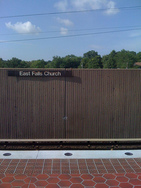Residents sound off about East Falls Church redevelopment
Arlington residents voiced familiar opinions for and against parking, traffic calming, and development at last week’s meeting on the East Falls Church plan. That plan calls for redeveloping low-density commercial properties and the Metro park and ride lot, as well as improving pedestrian and bicycle connectivity and major streetscapes.
Most commenters supported the general idea of the plan, but a few residents opposed it entirely. They cited an expectation, possibly a 1970s-era promise, that Arlington’s famous transit-oriented development would not come to East Falls Church.
The most frequently stated concern was the loss of parking from the Metro lot. Some residents that live nearby but farther than walking distance talked about how they use the parking lot for recreational travel to DC for sporting events. Other residents expressed a concern that the loss of the park and ride would result in increased spillover parking in local neighborhoods.
On the other hand, many residents were excited about the prospect of growth and density in the area. There were murmurs of approval at the mention of a possible grocery store. Resident Dennis (I didn’t catch his last name), a resident of Arlington since 1952, felt most of the changes he’s seen in the county have been good, including the development of walkable transit corridors in the north and south of the county.
Dennis turned the table on parking lot supporters, asking what their reaction would be if there were no parking lot or gas station and the task force had proposed building them. “This meeting would be full of people complaining about all the traffic problems it would cause.” Some other commenters cited their expectation when moving here that the area would be redeveloped, and said that they were looking forward to the changes.
Some others belittled traffic calming tools like bulb-outs, narrower lanes or similar measures. Max Jensen, who lives near Westover and commutes westward on Washington Boulevard, that in Arlington traffic had been calmed so much that, as he put it, it will be at a dead stop soon. He also asked whether it would make more sense to run feeder shuttles every 5 minutes rather than buses every 15 or 20.
Some residents were concerned about the impact of new residential buildings on already crowded schools. The local elementary school and middle school are already over capacity, and the school board has struggled with changing the neighborhood school boundaries for years.
Overall, there was not strong opposition to building on the commercial sites. There appeared to be a consensus that 6-story buildings near other large buildings and the Metro station were acceptable, with more support if the street fronts on Washington Boulevard and Sycamore were limited to 4 stories.

